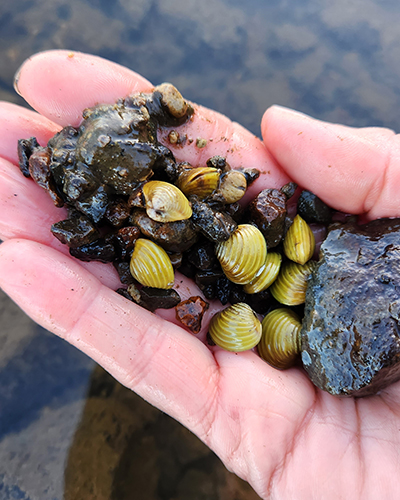“Our conversations with people over the summer included how often they take their boats and water gear between lakes for sporting events and recreational activities, especially within the Auckland, Waikato and Bay of Plenty areas, and how easy it is for a pest species to hitch a ride and take up residence somewhere else.”
- Michelle Archer, Waikato Koi Management Programme Lead
The discovery of gold clam has highlighted the importance of a Check Clean Dry advocacy campaign held at watersports events at Lake Karāpiro over the summer.
The Check Clean Dry campaign was held by the Waikato Koi Management Programme between January and May, targeting 10 major events that were attended by over 13,800 competitors and more than 25,000 spectators and supporters from around New Zealand.
The programme, which is a collaboration between Waikato Regional Council, the Department of Conservation, Waikato River Authority and Te Riu o Waikato, held the campaign as it recognises Lake Karāpiro as a high-risk source for spreading koi and other freshwater pest species due to its volume of users.
Programme lead Michelle Archer says within days of the campaign ending, the invasive gold clam was found in the Bob’s Landing area of the Waikato River near Lake Karāpiro, and it has since been discovered along 50 kilometres of the Waikato River – from Lake Maraetai to Hamilton.

Gold clam has the potential to cause significant damage to the local ecosystems of the Waikato River and other New Zealand waterways if people do not heed the Check Clean Dry method.
Michelle says before the find, it was known that Lake Karāpiro was home to several highly invasive freshwater fish and weed species, including hornwort, lagarosiphon, koi, goldfish, rudd, catfish, gambusia and possibly perch.
“And now we know we have this incredibly invasive gold clam, which has never been successfully eradicated overseas and has the potential to cause significant damage to the local ecosystems of the Waikato River and other New Zealand waterways if people do not heed the Check Clean Dry method.”
Lake Karāpiro is a major sporting hub in the Waikato and is used by multiple national sporting bodies across New Zealand every year for a wide variety of events. The events targeted by the campaign included dragon boating, waka ama, sprint kayaking, rowing and a hydroplane racing series.
Michelle says the highest risk of spreading freshwater pests involves freshwater weeds species, which can have eggs or spat/juveniles of other freshwater pest species attached, getting caught on boat trailers and in ballast tanks and moved to other waterways.
“Our conversations with people over the summer included how often they take their boats and water gear between lakes for sporting events and recreational activities, especially within the Auckland, Waikato and Bay of Plenty areas, and how easy it is for a pest species to hitch a ride and take up residence somewhere else.
“If you really think about it, it’s entirely feasible. As an example, the gold clam is a prolific breeder. It self-fertilises and produce up to 400 juveniles a day! That’s all out there in the water.
“So having these conversations is a good way of getting it home to someone who enjoys being out on the water that it’s really important to ensure all their equipment is clean before it enters water.
“You only have to look at the South Island and the damage that didymo has done to some of their pristine and beautiful streams.”
The Check Clean Dry campaign will be run again between January and May in 2024.
For more information on Check Clean Dry go to thisisus.nz/check-clean-dry.
The Koi Management Programme has completed an eDNA analysis of lakes within the Waikato to identify koi-free catchments and feasibility assessments for installing fish barrier infrastructure at specific waterways to prevent koi passage to maintain koi-free status.




To ask for help or report a problem, contact us
Tell us how we can improve the information on this page. (optional)